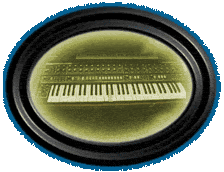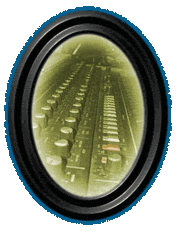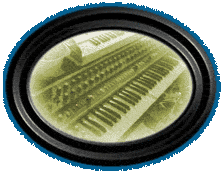Korg Trident mk II
Korg Trident mk II is a visually rather impressive instrument: heavy
(24 kg), wide and deep with thick wooden sides. The elegantly angled panel
contains rather large, smooth knobs and buttons with built-in LEDs. Just
by studying the design and turning the knobs you get the feel that the Trident
was meant to play with the big boys.
A quick view of the panel tells us that the Trident is divided in three sections: Synth, Brass and Strings. The reasonably well-versed synthetist will thereby conclude that this is a typical "multi instrument keyboard" - a kind of glorified string machine with some simplified synthesizer functions (see ARP Omni, Moog Opus 3, Korg Delta, etc.). This is only partly correct! The Korg Trident is actually designed the other way around - a true analogue polysynth (eight voices) with various functions for "simulating" a string machine.
Today this seems very pointless - who would want a string machine when you have a rather fat polysynth already? The Trident's instrument type specification gives us a clue - Korg called this device a "Performance Keyboard". That is, the Trident was intended for live use, and the different sections enabled quick combinations of the most common sound types, etc.
One could question whether this strategy was a good one. The synthetist that was wealthy enough (the Korg Trident mk II was sold for 32.000 SEK in the early eighties) would probably rather take a look at Roland's Jupiter series or some of the American giants. Maybe Korg figured the Trident koncept would appeal to keyboardist who felt intimidated by too many parameters and advanced functions? Anyway, the solid and thorough quality pays off today, and we don't hesitate to call Korg Trident mkII the king of multi instrument keyboards (and also a very nice sounding but somewhat limited analogue polysynth).
The Trident mkII was release in 1982, a couple of years after the original Trident. The two instruments have the same basic features and sound, but the successor has a few significant improvements and some smaller modifications, particularly in the synth section (se the table below).
Architecture and functions
As stated above, the Trident has three sections: Synth, Brass and Strings:
The Synth section has double VCOs; one with sawtooth, PW and PWM (with
separate rate control), the other with sawtooth wave only. Both oscillators
have switches for 16/8/4' and VCO 2 can be detuned for fat chorus-like sounds.
 However, you can't tune one oscillator to a
larger interval (e.g. a fifth), and there's no balance control or mixer
for the two VCOs (although VCO2 can be turned off and VCO 1 can be silenced
by maxing the pulse width). Also, there are no modulation capabilities here
- vibrato can instead be applied globally for all sections (see below).
However, you can't tune one oscillator to a
larger interval (e.g. a fifth), and there's no balance control or mixer
for the two VCOs (although VCO2 can be turned off and VCO 1 can be silenced
by maxing the pulse width). Also, there are no modulation capabilities here
- vibrato can instead be applied globally for all sections (see below).
The oscillators are followed by the filter, which is fairly typical for the polyphonic synths of that time: a 24 dB/octave low pass filter (SSM 2044, for the curious) with controls for cutoff frequency, resonance, keyboard tracking and envelope amount (negative or positive). Separate ADSR envelopes for filter and amplitude, a volume control and an "Auto Damp" switch (cuts off the release of lingering notes when a new note is played) finishes the parameter set.
The synth section is programmable, with 32 programs. We normally use the "Manual" mode, though.
The Brass section is a bit like a simplified synth section: one oscillator (sawtooth, 18 and/or 8'), a 24 db/octave filter with cutoff, resonance, positive envelope amount but no keyboard tracking. One ADSR is common for filter and amplitude; unfortunately there is no "gate mode" for the amplitude, something that otherwise is usual for single envelope instruments.
It's important to note that the Brass filter and envelope are common to all eight voices. You can choose between single and multiple trigger, though. There is also an unusual Trigger Select mode, where you can specify how many notes should be required for the envelope to be triggered. If you set this to e.g. "4", the Brass section will be silent as long as you don't press four keys or more. You can also trigger the envelope from an external signal, by means of a jack on the back of the instrument.
Just like the Brass, the String Section is based on sawtooth wave from the Synth section's VCO 1. It can deliver 16, 8 and/or 4'. The parameters include a simple equalizer (bass/treble), a separate LFO for vibrato (with delay, depth and rate), a kind of key track filter and the "bowing" effect. This is meant to emulate the bowing at the beinning of new notes by momentarily pushing the resonance of a simple filter. You can adjust the amount of effect and the frequency of the filter, but the result is hardly bow-like. All of this wouldn't sound very special if it wasn't for the "Ensemble" function - a chorus (Solina String Chorus, according to some sources) that makes the sound rich, warm and swirly.
To the left on the synth panel is a Performance section with the following functions:
An analogue flanger with controls for rate, depth, manual and feedback. The section of your choice (one at a time) can be sent through this for various special effects (some extra noise is added too, but the results can often be worth it). If you turn up the feedback, the flanger starts to self-oscillate, and this can with some work be used as a sound source in itself (listen to "Stormy Weather").
 Each section has a switch that determines
whether the section should be played from the lower or upper part of the
keyboard, or from the whole keyboard. The splitpoint is two octaves up from
the lowest key. Note that the voices are not divided between the keyboard
halves - you always have access to exactly eight voices, regardless of where
you play on the keyboard. This is of course due to the fact that Brass and
Strings use the same oscillator as the Synth section.
Each section has a switch that determines
whether the section should be played from the lower or upper part of the
keyboard, or from the whole keyboard. The splitpoint is two octaves up from
the lowest key. Note that the voices are not divided between the keyboard
halves - you always have access to exactly eight voices, regardless of where
you play on the keyboard. This is of course due to the fact that Brass and
Strings use the same oscillator as the Synth section.
A switch for Key Assign, the function of which the reviewer cannot explain clearly at this point. It has something to do with whether sounding released notes should be cut off or not, but it also seems to affect the re-triggering of the Synth section's filter envelope occasionaly. Strange.
An on/off-switch for Delayed Vibrato, with a separate Intensity knob. This vibrato affects all sections and the delay time cannot be adjusted.
Finally a joystick with pitch bend horizontally and vibrato/trill (pitch modulation with sine or square wave) vertically, if Delayed Vibrato is off. An Intensity knob sets the pitch bend range (up to more than ±1 octave) and the depth of the vibrato. Another knob sets the rate of the vibrato LFO (the same LFO is used for Delayed Vibrato and joystick-vibrato/trill). Regarding the actual joystick it must be said that this is one of the best pitch bend controls yours truly has encountered. Quick spring-back, high sensitivity and excellent for handmade vibratos and similar.
The instrument has a 61 note keyboard which is rather good (although one key is broken on our Trident and temporarily fixed with textile tape by a previous owner). The back panel offers five outputs (separate for each section plus two mix outputs), a number of inputs for volume control, a trig (GND) input for the Brass envelope and CV inputs for modulating filter CV in the Synth and Brass sections.
Sound and usage
What the Trident lacks in sonic flexibility (no noise generator, few waveforms, no portamento, no internal filter modulation, no sync or ringmodulator effects, etc) it partly balances with its warm, full sound. The filters sound very beautiful too, and the envelopes have a nice snappiness. Also, one shouldn't overlook the possibility to blend two or three sounds - excellent sounds can be created e.g. by having the synth section act as attack phase and brass or strings act as sustain.
For SHotQ, the Trident is the number one choice when it comes to polyphonic stuff such as brass, pads and chord comping. But the nice joystick also makes the instrument suitable for soloing and melody lines.
For a taste of the mighty tonal palette of the Trident mk II, listen to Stormy Weather (where everything except rain, wind and thunder is the Trident) or East S:t Louis Toodle-oo (where the Trident plays the lead trumpet, with and without wah pedal).
For the obsessed
The differences between Korg Trident mk I and mk II
| mk I | mk II | |
|---|---|---|
| Programmability | 16 memories; saved sounds cannot be edited. | 32 memories, saved sounds can be edited. |
| Filter Key Tracking | Off, Half, Full | Off, Quarter, Half, Full, Over |
| Envelopes | Common for VCF and VCA; VCA has Gate switch. | Separate for VCF and VCA. |
| Presets | Piano I, Piano II and Clav | Nope. |
| Pitch Bend Range | 7 semitones (if our memory serves us right). | 12 semitones |
| Huge cooling flanges on the back | No | Yes |